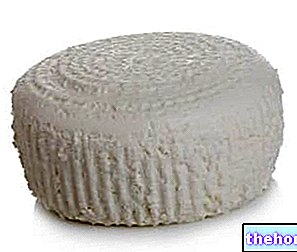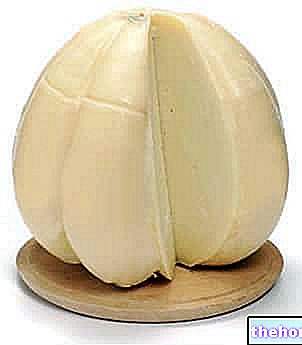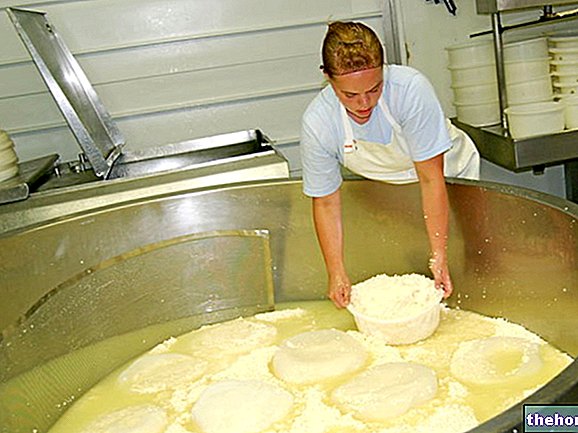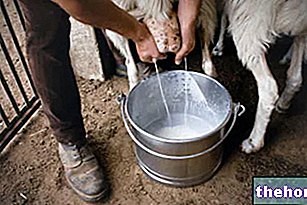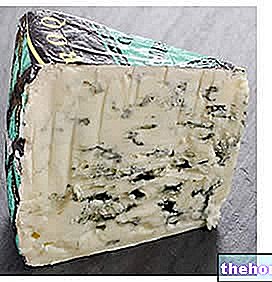Legal and commodity definition of milk
International Congress for the Suppression of Food Fraud - Geneva 1908
Milk is the integral product of the complete and uninterrupted milking of a healthy, well-fed and non-fatigued dairy female. Therefore, milks from sick, malnourished animals and milks containing colostrum (less than seven days after calving) are not suitable for human consumption.
The milk must be collected correctly; it must not be colored or smelly; it must not contain pathogenic microbial species.
NB. In Italy, "milk" refers exclusively to cow's milk; otherwise it is essential that the different animal species be specified on the product label, for example "buffalo milk".

Nutritional information
Milk is an organic product (intended as a biologically structured fluid and not as a food production specification), it is also a processing ingredient ... but first of all it is a food!
Milk is an essential nutritional source for the initial growth of mammalian offspring; it is produced by the mammary gland of females (emunctory gland) and its composition varies according to: species, lactation phase and individual variability. Milk is white and opalescent, has an almost neutral pH and its composition is extremely complex; it is in fact a lipid emulsion of globules immersed in a matrix similar to blood plasma. Even the aqueous portion has some dissolved molecules (proteins), without which it is possible to isolate the so-called serum (neutral solution containing lactose and mineral salts ).
From a chemical and nutritional point of view, milk is composed of:
- Lipids (especially triglycerides)
- Proteins (caseins, albumin and globulins)
- Glucides (lactose)
- Mineral salts (calcium, phosphorus, etc.)
However, what most affects the digestibility of milk is its composition in macronutritional energy molecules, i.e. only the first three categories of the four mentioned above.
Curiosity: milk is an extremely complex food!
Milk is a real mixture; it is the mixture of many substances but all in reciprocal equilibrium, which physically give rise to chemical-physical-compositional portions: emulsion, suspension, solution.
Milk left at room temperature tends to separate, but this is certainly not a defect! It is enough to stop and think about the natural application of milk in nutrition, or rather from the squeezing of the breast directly to the digestive tract of the offspring; for this reason, there is no reason why milk should be predisposed to natural preservation.
The separation process divides respectively: the cream (fat globules), the curd (casein proteins coagulated by microbial activity) and the whey (soluble portion of the curd separation). The three portions just mentioned, in addition to distinguishing the macronutrients that characterize it, are also the starting point of dairy processing.
Milk digestibility: introductory considerations
Milk is NOT a highly digestible food; it contains a large quantity of water (which dilutes the digestive juices) and all the macronutrients, which require very different gastric pH conditions.
The digestibility of milk varies significantly based on:
- Sensitivity to lactose and its concentration in the product: Delactosed milk is always more digestible than normal milk, but it also has a higher glycemic index
- Skimming level: whole milk has more fat globules (which must be digested) than semi-skimmed and skimmed milk; for this reason it presents greater digestive difficulties
- Amount of protein: skimmed milk is more protein (albeit slightly) than whole milk; however, the lower presence of lipids gives it a digestive advantage such as to largely compensate for the greater need for gastric acid denaturation (protein difference oscillating between 1.8-2g / 100 of edible portion)
Macronutrients of milk, organic chemistry and digestibility
Carbohydrates - lactose(4.7g per 100g, in whole milk): Lactose is an exclusive component of milk and is not found in other foods found in nature. It is a simple carbohydrate, more precisely a disaccharide formed by glucose + galactose. Lactose is found in different concentrations between the milk of different mammals and also in the different phases of lactation. Like other carbohydrates, it provides 3.75 kcal / 100g but its energy availability MAY "be limited by individual tolerance; in this regard, we remind you that lactose intolerance constitutes (together with that towards gluten) the only clinically detectable intolerance with a certain reliability (by means of the H2 Breath-test).
The high incidence of lactose intolerance among the general population is convincing many people (professionals and laymen) that drinking milk after weaning is NOT a completely correct practice. In reality, lactose intolerance is determined by the deficiency (more or less important) of an enzyme located in the brush border of the intestine: lactase (β-1,4 galactosylase). NB. it is also possible to find quite serious symptoms referring to an "other enzymatic deficiency of a hepatic nature, the insufficiency of galactase (Galactose-1-phosphate uridyltransferase). In this case it is more correct to speak of galactose intolerance.
By itself, not being able to hydrolyze lactose into glucose + galactose would not represent a big problem, were it not that this disaccharide is an excellent substrate for the bacteria present in the colon; this fermentation phenomenon gives rise to a strong production of gas and hyperosmotic agents that draw water from the intestinal mucosa. This phenomenon can generate a more or less intense enteric symptomatology, which can vary according to: quantity of milk ingested, level of lactase deficiency, potential for fermentation of the colonic bacterial flora and individual susceptibility. It should be noted that "lactose intolerance is prevalently widespread in areas where for centuries no milk has been consumed, but on the contrary, it is rarer in traditionally pasteurized areas. It is therefore obvious that the presence or absence of lactase is influenced by many variables. inter and intra individuals, as well as from the genetic and family patrimony; NB. also other pathological intestinal conditions (gastrointestinal infections) or morbid (Crohn's, ulcerative colitis, etc.), can negatively affect the presence of lactase in the mucosa.
Lactose has a glycemic index of 40-50, therefore, after hydrolysis, it is released into the blood twice as slowly as glucose (glycemic index 100). This results in a lower impact on the insulin response, favoring the control of lipogenesis. in order to guarantee the maximum level of digestibility even in lactose intolerant subjects, the food industry has started the production of a modified milk also known as delactosed milk.
Lipids(3.6g + 11mg 100g, in whole milk): the most present compounds are triacylglycerols or triglycerides, which determine the physical properties of milk and act as solvents for other lipids or liposoluble molecules. Among the fatty acids esterified with glycerol, saturated ones abound, in particular short-chain α, which are more easily attacked by endogenous lipases and are more digestible than other saturated fatty acids. Other lipid components of milk are phospholipids and sterols, and among the latter the most important is undoubtedly cholesterol (11mg / 100g of whole cow's milk). The lipid or lipophilic substances of minor quantitative importance are: carotenoids (pro vitamin A), tocopherols (vit E), xanthophylls (similar to carotenoids), squalene (triterpene hydrocarbon) etc.
Milk fats are organized in emulsified blood cells in the whey; the stability of this condition is favored by the structure of the blood cells themselves, characterized by a negatively charged lipoprotein outer membrane. They have a diameter ranging from 0.1 to 20 µm but in cow's milk, on average, they are between 2 and 6µm. The average chemical composition of the blood cells is:
- Triglycerides 95.7%
- Diglycerides 2.3%
- Phospholipids 1.1%
- Cholesterol 0.5%
- Free fatty acids 0.3%
- Enzymes 0.1%
- Others
Structurally, inside the globule there are low melting point glycerides (especially triglycerides), medium melting point glycerides and externally a cortical zone composed of phospholipids, triglycerides, cholesterol and lipoproteins.
Proteins(3.3g 100g, in whole milk): milk proteins can be divided into 3 groups ordered in a quantitatively decreasing manner. The first group consists of casein αs1, αs2, β and k, β-lactoglobulin, α-lactalbumin (89% of the total nitrogen); the second group contains serum albumin, immunoglobulins, lactoferrin, proteose peptone 3 and ceruloplasmin (2% of "total nitrogen). The third group contains post-secretory proteolysis peptones, hence γ caseins (from β casein) and δ caseins (from α casein; 3% of total nitrogen). Finally, a minor part of the total nitrogen derives from nitrogenous substances of a non-protein nature.
Bibliography:
- Milk science - C. Alais - New techniques - page 3: 5 - page 19 - page 27
- Milk chemistry and technology - C. Corradini - New techniques - page 57- page 70
Milk, Dairy Products and Cheeses Asiago Brie Burrata Caciocavallo Rennet Camembert Cheddar Milk Cream Crescenza Emmental Feta Milk Flakes Fontina Herbal Cheeses Lean Cheeses Cheeses rich in calcium Gorgonzola Gouda Grana Padano Gruyere Kéfalair Adapted milk Artificial milk Condensed milk Asphyxiated milk Goat's milk Sheep's milk Rice milk Soy milk Powdered milk and concentrated milk Skimmed and semi-skimmed milk Lactose-free milk Milk Vegetable milk Dairy products Lerdammer Mascarpone Montasio Buffalo mozzarella Mozzarella Whipped cream Cooking cream Fresh cream Parmigiano Reggiano Pecorino Philadelphia Primo Sale Provolone Ricotta Robiola Roquefort Scamorza Sottilette Squacquerone Taleggio Tomino Yogurt OTHER ARTICLES MILK AND DERIVATIVES Categories Alcoholic foods Meat Cereals and derivatives Sweeteners Sweets Offal Fruit Dried fruit Milk and derivatives Legumes Oils and fats Fish and fishery products Cold cuts S pezie Vegetables Health recipes Appetizers Bread, Pizza and Brioche First courses Second courses Vegetables and Salads Sweets and Desserts Ice creams and sorbets Syrups, liqueurs and grappa Basic preparations ---- In the kitchen with leftovers Carnival recipes Christmas recipes Light diet recipes Women's Day, Mum, Dad Recipes Functional Recipes International Recipes Easter Recipes Recipes for Celiacs Recipes for Diabetics Recipes for Holidays Recipes for Valentine's Day Recipes for Vegetarians Protein Recipes Regional Recipes Vegan Recipes

